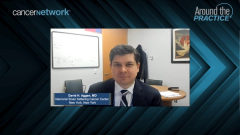
Favorable-Risk RCC: AE Management and Dosing With TKI/IO Therapy
A comprehensive review of the adverse event profiles of TKI/IO regimens used in favorable-risk renal cell carcinoma and how these can be managed with dose adjustment.
Episodes in this series

Transcript:
Robert J. Motzer, MD: David, you brought up a fascinating aspect in terms of the half-life of these different drugs and how they influence toxicity. With lenvatinib and pembrolizumab, in your own practice, what’s your sense in terms of starting patients at the full dose, at 20 mg of lenvatinib? And for the dose-reduction aspect of it, how do you handle that in your own practice?
David H. Aggen, MD: It’s a great question. I make every effort to stay true to the trial and start on 20 mg of lenvatinib. However I have a few personal rules I tend to follow: if a patient is over 80 years old, has an ECOG [performance status] of 2, or has blood pressure that’s poorly controlled, between a systolic of 140 to 160 routinely, I will start them on a reduced dose. I have a handful of patients over 80 who I’ve started on 10 mg of lenvatinib, and I’ve been able to titrate up. I do think in the real-world patient populations we have to be a little more creative about lenvatinib dosing. For patients who are younger and fitter, I tend to start at 20 mg and dose reduce as I run into toxicities. But there are some circumstances why we’ll start at a slightly reduced dose of lenvatinib. I have patients on lenvatinib 4 mg with pembrolizumab who are continuing to respond. I think it’s more important that patients can stay on some dose of the TKI [tyrosine kinase inhibitor] longitudinally rather than have frequent dose holds.
Robert J. Motzer, MD: Thanks. In terms of the class, the IO [immunotherapy]/TKI, these 3 different combinations have a similar adverse effect profile. So Brian, when you’re discussing this with patients and so forth, what do you feel are the standout adverse events that you need to talk to your patient about, and what do you follow up on with all these combinations? I think they all have a similar toxicity profile, so what’s your sense on the adverse event profile in general for these programs?
Brian I. Rini, MD: Yes, I generally talk about categories of TKI toxicities: fatigue, diarrhea, hand-foot syndrome, hypertension especially, the TKI toxicities we’re all familiar with from 20 years of use. Then separately, I’ll talk about the inflammatory IO toxicities, which are some of the same toxicities, such as diarrhea, etc, although a different mechanism of course. I tend to give them an overview of that, and I tend to stress that everybody’s different, and we’re starting a lot of people at the same dose, which isn’t going to be the right dose. Give us several weeks if not a few months to get it right, and that they need to tell us about adverse effects. We don’t have cameras in their house, we’re not sure what’s going on, and people can get sick in a hurry, as you all know.
I tend to talk in generalities about those adverse effects. I’m lucky enough to have a pharmacist who then comes in the room after me to give handouts and go into a little more granular detail about with or without food for the drugs and things like that. Then we see patients certainly every 3 weeks when they have their infusions, at least early on in these regimens, either myself or my nurse practitioner will see them. I really find it’s those first several weeks that are critical. If patients can get off to a good start and get on the right dose of TKI, they do well. If they get off to a bad start, it just doesn’t go well. They tend to want to quit the TKI altogether or end up in the hospital, and so those first several weeks are critical.
Robert J. Motzer, MD: Thanks. This patient had a dose reduction for toxicity, Mehmet, based on the hand-foot syndrome. One of the questions that comes up when you are dose reducing patients, their question is, “Should I really do this? Is this going to affect my outcome?” I’m sure you’ve heard that from patients who are concerned about dose reduction in the setting of toxicity, that it is going to affect their outcome. How do you manage that question from a patient?
Mehmet A. Bilen, MD: I think, Bob, this is very important because when we treat those patients, sometimes when we lower the dose, they worry about, “Am I going to lose the benefit?” But at the end of the day, I remind them that quality of life is very important, and keeping them on the treatment as long as possible is also very important. If I have a patient who has a very good PS [performance status] and no significant frailty, as David mentioned earlier, I also start Lenvima [lenvatinib] at 20 mg, and based on the type and severity of the toxicity, we can hold or we can reduce. We are all familiar with VEGF TKI toxicity, and they are very predictable. But again, we really don’t know patient by patient, race by race, region by region, the PK [pharmacokinetics] and PD [pharmacodynamics] of those drugs. For this reason, I think as long as the patient is tolerating it, I am comfortable that they are benefitting, even if we need to do a dose reduction. But if I have a patient for whom I really worry about the tolerance, I think starting at a lower dose and increasing it is also a very valid choice. Again, I think quality is very important. Quantity is very important also.
Transcript edited for clarity.
Newsletter
Stay up to date on recent advances in the multidisciplinary approach to cancer.
























































































